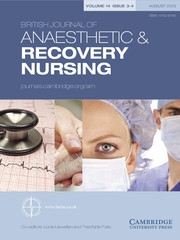No CrossRef data available.
Article contents
Lone Working in the Post Anaesthetic Care Unit is Patient Care Compromised?
Published online by Cambridge University Press: 25 February 2009
Extract
This article discusses staffing levels in the Post Anaesthetic Care Unit, following key recommendations that have been documented in response to the changing nature of both anaesthesia and surgery. An audit was carried out at the unit in York Hospital to determine whether the staff felt that patient care and staff vulnerability was compromised during times when the Recovery nurse worked alone.
- Type
- Research
- Information
- Copyright
- Copyright © British Association of Anaesthetic and Recovery Nursing 2004
References
REFERENCES
The Association of Anaesthetists of Great Britain and Ireland. Audit recipe book, section 3, Post Operative Care. London, 2002Google Scholar
The Association of Anaesthetists of Great Britain and Ireland. Immediate Postanaesthetic Recovery. London, 2002.Google Scholar
Brocklehurst, N, Walsh, K. Quality and the New NHS Nursing Standard 1999; 8(13): 15, 46–53.CrossRefGoogle Scholar
Department of Health. A First Class Service. Quality in the New Health Services Circular 1998/113. London, 1998.Google Scholar
Hatfield, A, Tronson, M. The Complete Recovery Room Book(3rd edn). Oxford: Oxford University Press, 2001.Google Scholar
The NCEPOD Report. ‘Who operates when?’. National Confidential Enquiry into Postoperative Deaths. London, 1997.Google Scholar
The NCEPOD Report. ′Who operates when? IF. National Confidential Enquiry into Patient Outcome and Death. London, 2003.Google Scholar
Oakley, M. Immediate Postanaesthetic Recovery. British Journal of Anaesthesia &C Recovery Nursing2003;4(1).Google Scholar
Phillips, J. Airway Problems. Raising the Standards. Royal College of Anaesthetists. London, 2000.Google Scholar
Wadw, S. Geringer, S. Recovery Room Staffing. Raising the Standards. Royal College of Anaesthetists. London, 2002.Google Scholar


